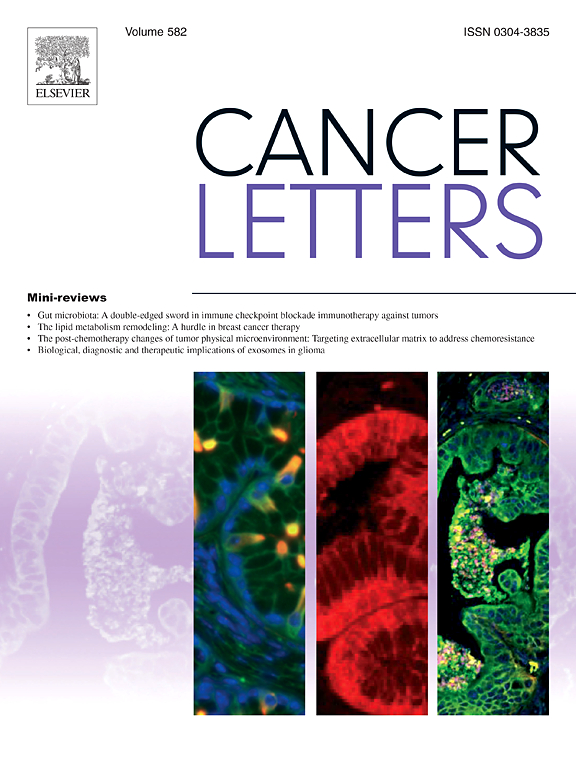代谢看门人ACAD9通过线粒体复合体I协调亚油酸代谢和氧化还原稳态,驱动卵巢癌进展。
IF 9.1
1区 医学
Q1 ONCOLOGY
引用次数: 0
摘要
平衡高代谢活性和氧化还原稳态对于癌症进展至关重要,特别是在高级别浆液性卵巢癌(HGSOC)中,它在富含游离脂肪酸的富脂环境中生长,但这种平衡的关键分子调节因子尚不明确。通过原位卵巢癌(OC)小鼠模型的体内全基因组CRISPR/Cas9敲除筛选,我们发现ACAD9是OC进展的关键驱动因素,其表达升高与患者预后不良相关。多组学整合分析和机制研究揭示了ACAD9在维持OC代谢稳态中的双重作用。ACAD9保持电子传递链完整性,调节亚油酸(LA)代谢,维持能量产生,同时减轻氧化应激。ACAD9缺乏会引发线粒体呼吸衰竭,诱发以氧化磷酸化失效和活性氧(ROS)积累为特征的代谢危机。引人注目的是,在LA富集的条件下,ACAD9的损失将LA通量从β-氧化转向膜脂生物合成,增加了多不饱和脂肪酸的掺入。这种膜重塑与ROS过载协同作用,形成触发铁下垂的“完美风暴”。我们的研究结果阐明了ACAD9在OC中的双重代谢监护作用,证明了它在协调线粒体呼吸和脂质稳态以避免铁下沉方面的关键作用,这为OC的治疗提供了一个潜在的靶点。本文章由计算机程序翻译,如有差异,请以英文原文为准。
Metabolic gatekeeper ACAD9 coordinates linoleic acid metabolism and redox homeostasis via mitochondrial complex I to drive ovarian cancer progression
Balancing high metabolic activity with redox homeostasis is crucial for cancer progression, particularly in high-grade serous ovarian cancer (HGSOC), which thrives in a lipid-rich environment abundance in free fatty acids, yet the key molecular regulators of this balance remain undefined. Through an in vivo genome-wide CRISPR/Cas9 knockout screen in an orthotopic ovarian cancer (OC) mouse model, we identify ACAD9 as a pivotal driver of OC progression, with its elevated expression correlating with poor patient prognosis. Multi-omics integration analysis and mechanism studies reveal ACAD9's dual role in maintaining OC metabolic homeostasis. ACAD9 preserves electron transport chain integrity and regulates linoleic acid (LA) metabolism to sustain energy production while mitigating oxidative stress. ACAD9 deficiency triggers mitochondrial respiratory collapse, inducing metabolic crisis marked by oxidative phosphorylation failure and reactive oxygen species (ROS) accumulation. Strikingly, under LA-enriched condition, ACAD9 loss redirects LA flux from β-oxidation toward membrane lipid biosynthesis, increasing polyunsaturated fatty acids incorporation. This membrane remodeling synergizes with ROS overload to create a “perfect storm” triggering ferroptosis. Our findings elucidate the dual metabolic guardianship of ACAD9 in OC, demonstrating its critical role in orchestrating mitochondrial respiration and lipid homeostasis to evade ferroptosis, which offer a potential target for the treatment of OC.
求助全文
通过发布文献求助,成功后即可免费获取论文全文。
去求助
来源期刊

Cancer letters
医学-肿瘤学
CiteScore
17.70
自引率
2.10%
发文量
427
审稿时长
15 days
期刊介绍:
Cancer Letters is a reputable international journal that serves as a platform for significant and original contributions in cancer research. The journal welcomes both full-length articles and Mini Reviews in the wide-ranging field of basic and translational oncology. Furthermore, it frequently presents Special Issues that shed light on current and topical areas in cancer research.
Cancer Letters is highly interested in various fundamental aspects that can cater to a diverse readership. These areas include the molecular genetics and cell biology of cancer, radiation biology, molecular pathology, hormones and cancer, viral oncology, metastasis, and chemoprevention. The journal actively focuses on experimental therapeutics, particularly the advancement of targeted therapies for personalized cancer medicine, such as metronomic chemotherapy.
By publishing groundbreaking research and promoting advancements in cancer treatments, Cancer Letters aims to actively contribute to the fight against cancer and the improvement of patient outcomes.
 求助内容:
求助内容: 应助结果提醒方式:
应助结果提醒方式:


